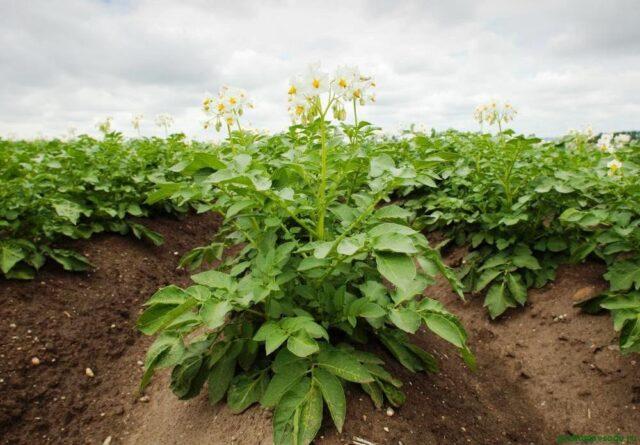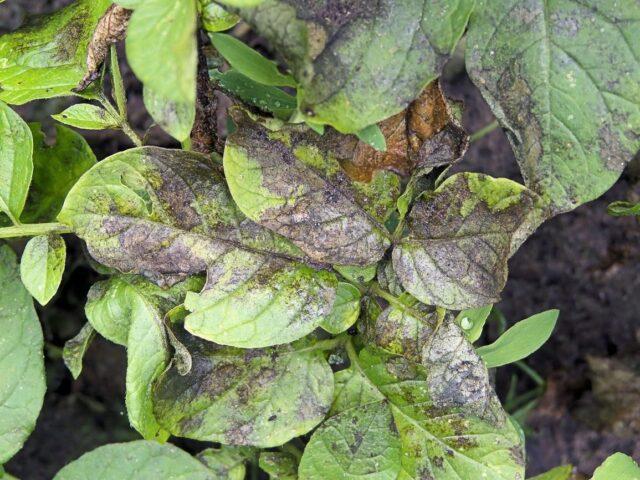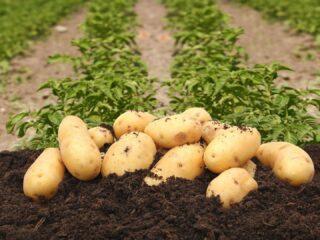Content
Unica potatoes are a variety that can be called “original and unique.” It is not very popular among Russian gardeners, although, as practice shows, it adapts well to the climate of the middle zone and even more severe conditions. They plant Unica mainly for the sake of experiment, wanting to grow something unusual on their plot: both the appearance of the plants and the taste of the tubers are specific.
History of appearance
The homeland of the Unica potato variety is South America (Peru), author – Jorge Alberto Espinosa. It is not listed in the domestic State Register of Selection Achievements.
This potato came to Russia in the mid-2000s almost by accident. Tubers for comparative testing of varieties bred in Russia, the Netherlands and South America were brought to Omsk by an employee of the Academy. K. A. Timiryazeva and concurrently the chairman of the local potato growers club.There is another version, according to which one of the city local government employees was “responsible” for “introducing” Russian gardeners to Unika potatoes.
The Siberian gardener V. S. Obushev played a major role in the “popularization” of the variety. Not only was he among the first to plant Unica potatoes as an experiment, but he was also able to obtain new tubers that retained varietal characteristics from seeds.
Description of Unica potato variety
To understand the fact that Unica is a very unusual potato, just look at the plants and tubers themselves. His “appearance” speaks for itself.
Bush
The minimum height of Unika potato bushes is about 1 m. In a climate favorable for gardening (for example, in the south of Russia), the stems elongate much more - up to 1.8-2 m. The shoots are powerful, densely leafy. The root system is also well developed.

The bush consists of 6-7 stems, their base gradually turns brown, as if becoming lignified
The leaf blades of the Unica potato are small. Their shade is close to light green, much lighter than most varieties and hybrids. Flowering is abundant, but short-lived (4-5 days). The flowers are snow-white.
Tubers
The tubers of Unika potatoes are large or very large, weighing 0.75-1.5 kg. The peel is quite thin, elastic, practically without “eyes” (if there are any, they are rare and superficial), bright crimson in color.
The pulp is uniform in texture, elastic and juicy, butter-colored or almost yellow. It retains its shape after heat treatment and does not boil over.

The shape of the tubers is close to oval, but more often irregular
Characteristics of Unica seed potatoes
The original appearance of the bushes and the large size of the tubers are not the only things that attract gardeners to Unica potatoes.There is no official description of its varietal characteristics, but gardeners identify many advantages.
Taste qualities of Unica potatoes
Unica potatoes have a specific taste. After cooking, a slight saltiness and sourness are clearly felt in it. Fried tubers will not be bland either. Therefore, sometimes when cooking they even do without spices.
Ripening time
According to the ripening period, Unika potatoes belong to the mid-season category. In Siberia, where it was originally introduced, the crop is dug up 80-95 days after the tubers germinate in the garden. But in the south, the process of their ripening goes faster by a week and a half, which allows us to classify the variety as mid-early.
Productivity
Consistently high yield is one of the characteristics for which Unica potatoes are highly valued by gardeners familiar with them. Each bush produces an average of 15 tubers, the size of which varies from large to very large.

A bucket of potatoes from a Unika bush and 300-320 kg per hundred square meters is quite realistic
Where is it grown?
Unica potatoes were originally brought to Siberia. There he quickly and successfully adapted to the peculiarities of the local climate, which is far from ideal for gardening. Accordingly, we can conclude that the variety is distinguished by excellent endurance and the ability to successfully withstand negative external influences.
Unika potatoes are suitable for any Russian region where gardening is, in principle, possible. The “experiments” of summer residents and the harvests they collect confirm this.
Disease resistance
There is no official data on the presence of “innate” immunity in the variety against any diseases typical for the crop. The same applies to information about the protection against pests provided by breeders. However, the experience of gardeners shows that plants demonstrate excellent resistance to pathogens and insects even in the absence of preventive treatments.

Gardeners have experimentally determined that Unika potatoes are almost not susceptible to late blight.
Advantages and disadvantages
The starch content in the Unica potato pulp is quite high (13%). But there is no “mealyness” in the taste.

According to the classification of professional culinary experts, Unica potatoes belong to type B, that is, they are suitable for preparing any dishes
Pros:
- the ability to withstand negative external influences without damage, including heat, drought, heavy rainfall, and temperature changes;
- consistently high yields ensured by large fruits and a large number of tubers in the “nest”;
- undemanding to the quality of the substrate;
- extremely rare cases of infection with typical crop diseases and pest attacks;
- excellent keeping quality and preservation of tubers after harvesting;
- large size, external presentability of potatoes;
- versatility in terms of cooking;
- original, memorable taste.
Minuses:
- the “large size” of the bushes requires large areas for planting;
- When hilling and harvesting, high tops create certain inconveniences;
- due to the “undeveloped” variety, difficulties often arise in purchasing planting material; its price is quite high;
- Small and medium-sized tubers convenient for planting are practically absent.
Planting Unica potatoes
For Unica potatoes, be sure to choose a well-lit area. The absence of groundwater close to the surface is also important. The quality of the substrate for this variety is not important, but the experience of gardeners shows that the highest yields and the highest quality tubers are harvested by planting it in sandy or loamy soil with a neutral or slightly acidic pH.
Planting dates for Unica potatoes are standard for the crop:
- the first ten days of May in central Russia;
- late May or early June in Siberia, the Urals, and other regions classified as “risky farming zones”;
- mid-April in the south.
The garden bed is prepared in the fall by carefully digging it up, clearing it of plant and other debris, and adding the necessary mineral and organic fertilizers. Before planting, it is advisable to loosen the soil well again.
Pre-planting preparation for Unica potatoes is often limited to germinating tubers for 3-4 weeks. Considering its good immunity and consistently high yield, many gardeners refuse to treat it with a fungicide and biostimulator solution. Unica potatoes are planted with an interval of at least 80-90 cm between tubers, leaving at least 1.5 m between rows (preferably 2 m).

The depth of the holes varies between 5-12 cm and depends on the quality of the substrate: the looser and “lighter” it is, the larger it is
Care instructions
The specifics of growing Unica potatoes are mainly due to the large size of the bushes. They need a “fan” garter; therefore, when planting, it is necessary to provide a place for placing a trellis. Without support, the shoots gradually droop; the lower leaves, deprived of light, become “ballast” for the bush, instead of providing it with nutrition.
Also, in the absence of trellises, weeding, loosening the soil in the beds, watering, and other agrotechnical measures necessary to obtain good yields of Unica potatoes are significantly difficult. Mulching partially solves this problem. By the way, gardeners who have been growing this variety for a long time recommend not neglecting it even if there is a trellis, using dried grass as mulch.

The design of the Unika potato trellis is standard - vertical supports and several horizontal tiers made of wire or twine
Also, caring for Unica potatoes includes the following basic measures:
- Watering. Here, recommendations vary - from the need to moisten the substrate twice a week to 4-5 waterings per season. The variety tolerates both drought and waterlogging well, so it is better to focus on the condition of the soil.
- Feeding. Fertilizers are applied three times per season: at the stage of the third true leaf, during the period of “mass” bud formation and flowering. The first fertilizing must contain nitrogen, the next ones must be complex.
- Hilling. The Unika potato bushes are earthed up for the first time when they grow to 15-17 cm in height, and again after two weeks.

Hilling helps increase productivity
Harvest and storage
Harvesting of Unica potatoes begins no earlier than the last ten days of August. A more realistic deadline for many Russian regions is the first half of September. The tops do not lie on the bed, but by this moment they turn yellow almost completely. Due to their large size, it is recommended to dig up Unica potatoes with a fork - this way there is less risk of damaging the tubers in the process.
For storage use any container that allows air to pass through. You need to find a room where a microclimate with the following parameters is constantly maintained:
- temperature 2-4 °C;
- air humidity 80-85%;
- good ventilation;
- absence of cold drafts.

It is impossible to immediately harvest the crop for storage; it is left to “dry” for at least 2-3 days, then sorted through, getting rid of the “substandard”
Conclusion
Unika potatoes differ from other varieties and hybrids in the unusual “appearance” of bushes and tubers and taste. Because of such originality, plants require specific care. And, although there is nothing too complicated in agricultural technology, it is the need to “master” its nuances that prevents the wide distribution of the variety in household plots.
Reviews from summer residents about Unika potatoes








